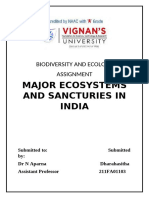Biomas de La Tierra en Ingles
Biomas de La Tierra en Ingles
Uploaded by
SAAM_BLDCopyright:
Available Formats
Biomas de La Tierra en Ingles
Biomas de La Tierra en Ingles
Uploaded by
SAAM_BLDOriginal Description:
Copyright
Available Formats
Share this document
Did you find this document useful?
Is this content inappropriate?
Copyright:
Available Formats
Biomas de La Tierra en Ingles
Biomas de La Tierra en Ingles
Uploaded by
SAAM_BLDCopyright:
Available Formats
THE BIOMES OF THE EARTH
Biome: Also called bioclimatic landscape or biotic areas, is a particular part of the
planet that shares climate, flora and fauna. A biome is the set of characteristic
ecosystems of a biogeographic zone is defined from the vegetation and animal
species predominate.
a) OCEANS:
It is called Ocean to the large volumes of salt water on Earth, which form most of
the planet's surface. The oceans are classified into three major oceans: Atlantic,
Indian and Pacific; and two minor Arctic and Antarctic, partially delimited by the
shape of the continents and archipelagos. The oceans contain the largest of all
biomes on Earth. Cover 71% of the surface of the Earth, the Pacific Ocean
being the greatest of all.
b) FRESHWATER:
Biomes freshwater bodies are much smaller than ocean water, but very
important. Freshwater biomes include lakes, rivers, streams and creeks. They
discharge their water in the oceans, usually from the mouths of rivers.
Freshwater biomes cover a fifth of the planet and are vital to our survival. More
than half of the drinking water for humans and animals comes from this
resource.
c) DESERT:
Desert is defined as a deserted place, not inhabited by humans or barely any
living being. The desert is exGVFTtremely hot and dry biome ie has little rainfall,
are at low latitudes, between the Tropic of Cancer and the Tropic of Capricorn.
Soft occur often winds that evaporate any moisture that may develop normally.
The heat is dry and makes it difficult for many types of plants and animals to
survive in these biomes. Approximately 20% of the Earth falls into this category.
Among the deserts we are: Deserts of Australia, Death Valley, Sonoran Desert,
Gobi Desert, Namibia Desert and the Sahara Desert.
d) FOREST:
A forest is an ecosystem where the predominant vegetation are trees and
bushes. These plant communities cover large areas of the globe and function as
animal habitats, hydrologic flow modulators, and soil conservers, constituting
one of the most important aspects of the biosphere of the Earth. Forests are
biomes that occupy one third of the total area of our land and contain about 70%
of carbon in living things. Without forests, the world would suffer dire
consequences that would affect every corner of our planet. The forest is
classified as: Tropical Forest, Temperate Forest and coniferous forests.
e) GRASSLANDS:
The grassland is a biome that scientists, is among the desert climate and forest,
as rains are not so everyday but there is more vegetation and fauna. Grasslands
or pastures, are a biome whose predominant vegetation consists of grasses and
shrubs. They develop in mid-latitudes where there are climatic variations
throughout the year to determine four distinct seasons, finding them along
certain areas of North America and Eurasia. In these places there are mountains
that prevent air masses from the ocean affect these areas.
f) TUNDRA:
The tundra which means Earth Inferti, describes the polar biogeographical
region, whose vegetation is low growth beyond the northern boundary of the
wooded area. It is a biome characterized by its icy ground, lack of woody
vegetation or, in any case, natural trees, which is due to poor heliophany and
glacial cold stress; soils, which are covered with moss and lichen, are swampy,
with peat bogs in many places. It is spread mainly by the northern hemisphere:
in Siberia, Alaska, northern Canada, southern Greenland and the Arctic coast of
Europe. In the southern hemisphere it manifests with temperatures more
partners during the year and in places like southern Chile and Argentina end,
sub-Antarctic islands such as South Georgia and Kerguelen, and in small areas
of northern Antarctica near the sea level. The tundra occupies about one-fifth of
the land area.
You might also like
- India As A Mega Diversity NationDocument14 pagesIndia As A Mega Diversity NationAshi Gupta72% (18)
- Types of BiomeDocument8 pagesTypes of Biomelizzie_mcgNo ratings yet
- Ecosystem - Lesson 2Document7 pagesEcosystem - Lesson 2Jhon Lloyd Zarco BantigueNo ratings yet
- New Microsoft Office Word DocumentDocument48 pagesNew Microsoft Office Word DocumentSuperpower KhilafahNo ratings yet
- Topic 8. BiomesDocument10 pagesTopic 8. BiomesKC Marien LopezNo ratings yet
- BiomesDocument5 pagesBiomesFatima AkramNo ratings yet
- Biomes of The WorldDocument12 pagesBiomes of The WorldOmaya Tariq100% (1)
- Biodiversity and Biomes Written Report (Group4)Document8 pagesBiodiversity and Biomes Written Report (Group4)aabayon2210062No ratings yet
- BiomesDocument117 pagesBiomesgeissingert93% (14)
- Biomes and LifeDocument8 pagesBiomes and Lifeapi-239851883No ratings yet
- BiomesDocument9 pagesBiomesbindujabavurupudi2006No ratings yet
- Terrestrial EcosystemDocument2 pagesTerrestrial EcosystemGie Marie Francisco Umali100% (1)
- Taiga (: Citation NeededDocument4 pagesTaiga (: Citation NeededLyraNo ratings yet
- G 4 PPT Wala Pang Ano YanDocument21 pagesG 4 PPT Wala Pang Ano YanPyrrhus John BagamaspadNo ratings yet
- Biomes LecDocument12 pagesBiomes Lecnicolaidayao18No ratings yet
- Terrestrial, Aquatic, Marine Ecology and CommunitiesDocument26 pagesTerrestrial, Aquatic, Marine Ecology and CommunitiesArnel AngelesNo ratings yet
- Biosphere To EcosystemsDocument13 pagesBiosphere To EcosystemsMig15No ratings yet
- BiomesDocument9 pagesBiomesbindujabavurupudi2006No ratings yet
- Biodiversity of Our TimesDocument14 pagesBiodiversity of Our TimesnelsapiNo ratings yet
- Tema 11: La EcosferaDocument10 pagesTema 11: La EcosferaAinhoa Pérez GiménezNo ratings yet
- Environmental ScienceDocument5 pagesEnvironmental ScienceJhupoor GargolesNo ratings yet
- Unit 2 - II - Ecosystem - Types of EcosystemDocument19 pagesUnit 2 - II - Ecosystem - Types of Ecosystempalak662005No ratings yet
- Biomes: How Many Biomes Are There?Document12 pagesBiomes: How Many Biomes Are There?Branlie RuetasNo ratings yet
- Ecosystems and Types of EcosystemsDocument42 pagesEcosystems and Types of EcosystemsIbrahim AliNo ratings yet
- Chapter 2 Envi SciDocument6 pagesChapter 2 Envi SciNadine PantiNo ratings yet
- Biosphere To EcosystemsDocument16 pagesBiosphere To EcosystemsleahNo ratings yet
- 6-Types of EnvironmentDocument49 pages6-Types of EnvironmentFatimaNo ratings yet
- HandOut (World Biomes)Document7 pagesHandOut (World Biomes)Jonel BarrugaNo ratings yet
- White Creative Doodle Brainstorming PresentationDocument17 pagesWhite Creative Doodle Brainstorming PresentationZyra AbordsNo ratings yet
- Terrestrial Ecosystems: Moscamuerta03Document82 pagesTerrestrial Ecosystems: Moscamuerta03mindmover0003No ratings yet
- EVS 1 - Unit - 1 - Environment and Its Components 1Document41 pagesEVS 1 - Unit - 1 - Environment and Its Components 1riysubhroNo ratings yet
- Week2, Lec1biology and Ecology of WildlifeDocument12 pagesWeek2, Lec1biology and Ecology of WildlifeRabia HanifNo ratings yet
- Honors Biology 5 8 14 PresentationDocument18 pagesHonors Biology 5 8 14 Presentationapi-239943146No ratings yet
- Biodiversity & Ecology-1Document22 pagesBiodiversity & Ecology-1Rohit kumar SarkarNo ratings yet
- About RainforestDocument4 pagesAbout RainforestAli AusatNo ratings yet
- The Biosphere and Animal DistributionDocument65 pagesThe Biosphere and Animal DistributionWendanakNo ratings yet
- RainforestDocument9 pagesRainforestSergio Ramiro Gonzales AguilarNo ratings yet
- What Is Biome? Biomes Are Very Large Ecological Areas On The Earth's Surface, With Fauna and FloraDocument2 pagesWhat Is Biome? Biomes Are Very Large Ecological Areas On The Earth's Surface, With Fauna and FloraMaria Zyra De MesaNo ratings yet
- Rain Forest: Rainforests Are Forests Characterized by High Rainfall, WithDocument56 pagesRain Forest: Rainforests Are Forests Characterized by High Rainfall, WithSathish KumarNo ratings yet
- Chapter 7Document37 pagesChapter 7daryl.pradoNo ratings yet
- BIODIVERSITY@ASSDocument9 pagesBIODIVERSITY@ASSdharahasitha03No ratings yet
- Biomes ActivityDocument3 pagesBiomes ActivitybabyduckiezNo ratings yet
- Different Types of Ecosystems: PolarDocument5 pagesDifferent Types of Ecosystems: PolarynaNo ratings yet
- What Is BiodiversityDocument3 pagesWhat Is BiodiversitySheena Mae PlancoNo ratings yet
- Terrestrial EcologyDocument16 pagesTerrestrial EcologyjessicaeliseNo ratings yet
- In 2 mặt 6 bảnDocument6 pagesIn 2 mặt 6 bảnchi.ntt2001No ratings yet
- Cpe214 Week 4Document9 pagesCpe214 Week 4Angel AngelNo ratings yet
- The Five Major Types of BiomesDocument3 pagesThe Five Major Types of BiomesFire LadNo ratings yet
- Forest EcosystemDocument10 pagesForest EcosystemHarish NatrajNo ratings yet
- Different Types of EcosystemsDocument3 pagesDifferent Types of EcosystemsCherry Brutas0% (1)
- Class Format 9º Axis 3 Biomes, Wheather Patterns in The Planet and BiodiversityDocument10 pagesClass Format 9º Axis 3 Biomes, Wheather Patterns in The Planet and BiodiversityMelissa FilizzolaNo ratings yet
- Final Module EnviSciDocument55 pagesFinal Module EnviSciJeff Ray BarreraNo ratings yet
- Biomes 1.1Document23 pagesBiomes 1.1cristinejoygenova43No ratings yet
- ACTIVITY3Document3 pagesACTIVITY3BS PSY Richelle Mae AndesNo ratings yet
- Major Biomes of The World WSDocument17 pagesMajor Biomes of The World WShorne.legaci6826No ratings yet
- Natural Ecosystem Aquatic EcosystemDocument32 pagesNatural Ecosystem Aquatic EcosystemCHRISTINA MAMARILNo ratings yet
- RAINFORESTDocument2 pagesRAINFORESTJesica Mesias EugenioNo ratings yet
- Apes-Introduction To The Worlds Biomes RepairedDocument7 pagesApes-Introduction To The Worlds Biomes Repairedapi-235658421No ratings yet
- Land and Aquatic BiomesDocument35 pagesLand and Aquatic Biomesapi-234480965No ratings yet
- Ilovepdf MergedDocument27 pagesIlovepdf MergedRinalyn AsuncionNo ratings yet
- Interactions in EcosystemsDocument42 pagesInteractions in EcosystemsDeniel DenamarcaNo ratings yet
- Food Chain Student Worksheet and ExtensionDocument4 pagesFood Chain Student Worksheet and Extensionapi-361126391No ratings yet
- Detailed Lesson PlanDocument9 pagesDetailed Lesson PlanLUCERO, NIERO FRANKNo ratings yet
- Laboratory Activity 1Document2 pagesLaboratory Activity 1Florence Roy P. Salvaña100% (1)
- Lakes and Reservoir in Malaysia: Management and Research ChallengesDocument7 pagesLakes and Reservoir in Malaysia: Management and Research ChallengesasyrafmuhddNo ratings yet
- Colwell y Rangel, 2009Document8 pagesColwell y Rangel, 2009Adriana CaballeroNo ratings yet
- 외부지문 (코끼리) 학습지Document2 pages외부지문 (코끼리) 학습지김다빈No ratings yet
- Environmental PoliticsDocument17 pagesEnvironmental PoliticsHannah Keziah Dela CernaNo ratings yet
- 4ge1 01 Que 20210428Document40 pages4ge1 01 Que 20210428Ivy Zaw LattNo ratings yet
- Ecocentrism and Anthropocentrism Moral Reasoning AboutDocument13 pagesEcocentrism and Anthropocentrism Moral Reasoning AboutGeorgiana PrisoschiNo ratings yet
- 1st Announcement of INWEPF-PAWEES MeetingsDocument5 pages1st Announcement of INWEPF-PAWEES Meetingsardian923No ratings yet
- Env Science 120 Lesson 18: Carrying CapacityDocument14 pagesEnv Science 120 Lesson 18: Carrying Capacityjohn kurniantoNo ratings yet
- Field TripDocument3 pagesField TripMELINDA PaulNo ratings yet
- Landscape Design and Site Planning: Assignment-07: VegetationDocument8 pagesLandscape Design and Site Planning: Assignment-07: VegetationSaleha FatimaNo ratings yet
- Chapter Ix - Urban Land Development and Transportation Infrastructure - Macasinag, LeonardDocument21 pagesChapter Ix - Urban Land Development and Transportation Infrastructure - Macasinag, LeonardPatricia Sofia DizonNo ratings yet
- Sole ReveiwDocument17 pagesSole ReveiwBarnababas BeyeneNo ratings yet
- Pillar 2A1 Ecology Ecosystem BiomeDocument40 pagesPillar 2A1 Ecology Ecosystem Biomesam paulNo ratings yet
- Extint SpeciesDocument22 pagesExtint SpeciesVikram TalwarNo ratings yet
- Classification of Boreal Forest Ecosystem Goods and Services in FinlandDocument197 pagesClassification of Boreal Forest Ecosystem Goods and Services in FinlandSivamani SelvarajuNo ratings yet
- Ge6351 Environmental Science and Engineering SyllabusDocument2 pagesGe6351 Environmental Science and Engineering Syllabusgahapa100% (1)
- Biodiversity LPDocument9 pagesBiodiversity LPjennica s. pilapil100% (1)
- Carrillo-Hermosilla, Del Río, Könnölä - 2010 - Diversity of Eco-Innovations Reflections From Selected Case Studies-AnnotatedDocument25 pagesCarrillo-Hermosilla, Del Río, Könnölä - 2010 - Diversity of Eco-Innovations Reflections From Selected Case Studies-AnnotatedRicardo PucinelliNo ratings yet
- Term 2 - Grade 8 Science Chapter 6 Conservation of Plants and AnimalsDocument3 pagesTerm 2 - Grade 8 Science Chapter 6 Conservation of Plants and Animalsris.aryajoshiNo ratings yet
- Forest Biomass Energy Policy in The Maritime Provinces: Accounting For ScienceDocument42 pagesForest Biomass Energy Policy in The Maritime Provinces: Accounting For ScienceKaren GordNo ratings yet
- Earth Scie 22Document26 pagesEarth Scie 22HayaradjNo ratings yet
- Myth of RainDocument3 pagesMyth of RainSoupenheimNo ratings yet
- 15ME562 Lesson PlanDocument3 pages15ME562 Lesson Planmurugeshmech22No ratings yet
- Wildlife Conservation Efforts in IndiaDocument8 pagesWildlife Conservation Efforts in Indiasahasarbani17No ratings yet
- NCE Biology SciencesDocument208 pagesNCE Biology SciencesDaniel IdokoNo ratings yet

























































































